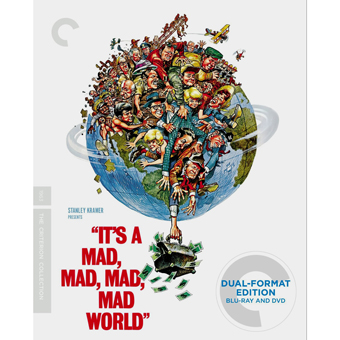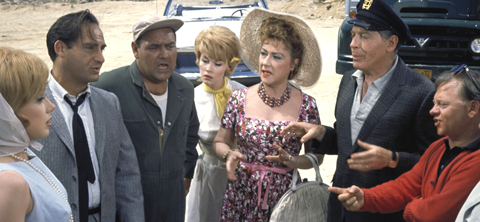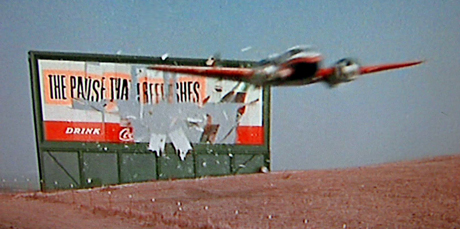|
|
It's A Mad, Mad, Mad, Mad World
Savant Blu-ray Review

|
It's A Mad, Mad, Mad, Mad World
Blu-ray
Criterion 692
1963 / Color / 2:76 widescreen (Ultra Panavision 70, aka Super Cinerama 70) / 163 & 197 min. / Street Date January 21, 2014 / 49.95
Starring Spencer Tracy, Milton Berle, Sid Caesar, Buddy Hackett, Ethel Merman, Mickey Rooney, Dick Shawn, Phil Silvers, Terry-Thomas, Jonathan Winters, Edie Adams, Dorothy Provine, Eddie 'Rochester' Anderson, Jim Backus, Ben Blue, Barrie Chase, William Demarest, Joe E. Brown, Andy Devine, Peter Falk, Norman Fell, Paul Ford, Stan Freberg, Leo Gorcey, Sterling Holloway, Marvin Kaplan, Edward Everett Horton, Buster Keaton, Don Knotts, Charles Lane, Mike Mazurki, Charles McGraw, Zasu Pitts, Carl Reiner, Madlyn Rhue, Roy Roberts, Arnold Stang, Jesse White, Jimmy Durante, Joe DeRita, Larry Fine, Moe Howard, Jack Benny, Paul Birch, Howard Da Silva, Jerry Lewis, Doodles Weaver.
|
|
|
|
|
Cinematography Ernest Laszlo
Film Editor Gene Fowler Jr., Robert C. Jones, Frederic Knudtson
Special Optical Effects Linwood Dunn
Stunt Supervisor Carey Loftin
Production Design Rudolph Sternad
Original Music Ernest Gold
Written by William Rose and Tania Rose
Produced and Directed by Stanley Kramer
Reviewed by Glenn Erickson
Only a few big-screen Road Show movies of the 1960s still perform as sure-fire audience grabbers -- attractions like Lawrence of Arabia and 2001: A Space Odyssey. Another title presently making an enthusiastic rebound is Stanley Kramer's all-star 1963 comedy extravaganza It's A Mad, Mad, Mad, Mad World. Just a couple of seasons before, Kramer's On the Beach had given movie audiences the most grim and downbeat ending imaginable: "It's a Dead, Dead, Dead...". The critically snubbed maker of ideologically safe "Big Issue" movies was considered the last producer in Hollywood to have a sense of humor. But with the blessing of United Artists Kramer sunk a fortune into a three-hour "marathon of mirth", timed to debut at the grand opening of Hollywood's new Cinerama Dome Theater. The construction made big news -- UA's publicity files contain reams of photos of various Mad World stars visiting the half-completed Dome ... and wondering if it would be finished in time for the premiere.
Produced on a gargantuan scale, Mad World is unlike any comedy before. Kramer signed practically the entire galaxy of comedy stars past and present, with a fair number of future comic talents to boot. Others in cameo appearances have instantly familiar faces going back as far as four decades. The moment we hear the inimitable Sterling Holloway we smile in recognition. Joe E. Brown's bellowing voice makes an impact even in a brief wide shot. Perhaps representing Preston Sturges, William Demarest does well in an extended role, while the normally non-comic actors Charles McGraw and Mike Mazurki fit in perfectly as tough guy straight men.

Every six year-old in the audience loved the film's first über-corny joke, when the fugitive crook played by Jimmy Durante literally kicks the bucket. A highway system and a big swath of Southern California are immediately caught up in an ultimate race-competition to recover a fortune in stolen loot. The screenplay by William and Tania Rose makes no claims to greatness but provides three solid hours of set piece scenes that allow the main cast of comic stars to shine. Mad World preserves personae that might now be lost to the memory of old TV series and variety shows. Sid Caesar is given an extended version of one of his Your Show of Shows double-talk marathons. Phil Silvers' TV image as a fast-talking conman is given a terrific big-screen showcase. By 1963 Milton Berle had a reputation as a guy who got laughs on fossil-era TV by wearing a woman's dress; here he plays a fairly complex henpecked husband, dealing with the worst battle-ax mother of all time. She's none other than Ethel Merman, an extrovert apparently game for any comedy nonsense, anytime, anywhere.
Also receiving a plum role is Terry-Thomas as the ultimate silly Englishman. Mad World aspires to a level of comedy above the slapstick-vaudeville level only when Terry-Thomas and Milton Berle trade opinions and insults about the emasculation of the American male. As for the institution of motherhood, Dick Shawn's sex-obsessed beach lothario has only two speeds in his gearbox. He's either zonked out dancing to the Twist, or howling in infantile emotional madness when he thinks his Mama is in trouble. Even Merman's shrill harpy is sobered somewhat by "Junior's" manic excess.
Some of the star names make big impressions in slightly smaller parts. Buddy Hackett and Mickey Rooney are greedy goofballs hitching a ride in the fancy airplane of millionaire Jim Backus -- the jokes are stock but their execution is flawless. Other star faces charm us by being wholly innocent. Primarily a stand-up comedian, the marvelous Jonathan Winters may be the freshest thing in the movie. He is immediately lovable, whether playing sad dismay or murderous rage. Guest star Don Knotts plays brilliantly off Phil Silvers as a hyper-neurotic motorist. Knotts can't be on screen for more than three minutes, and every jumpy-jittery move he makes is hilarious. Cabdriver Peter Falk is always in the company of bigger stars and hasn't any dedicated moments. Yet he sets the record for the number of stolen scenes.
1963 is not the best year to find sex or race equality. Dorothy Provine and Edie Adams are comic decoration, mostly there to look on while their husbands wreck half of California. Provine at least contributes a rare non-greedy attitude to the mix. Meanwhile Barrie Chase seems to have transferred her sex drive to her dancing, as she gyrates in a black bikini. She plays straight woman to Dick Shawn, but one must listen carefully to pick up on the fact that she's meant to be a philandering married woman. Eddie "Rochester" Anderson lends his distinctive voice to his role as a cabbie, but in an earlier bit, black actor Nick Stewart is called upon to do a Mantan Moreland-style "take" when the fortune hunters run his truck off the road.

Holding the center of the mayhem is police chief Spencer Tracy, the straight-man anchor keeping Mad World from spinning off into utter incoherence. He's so desperate to escape from his hysterical wife and daughter that he's willing to commit a felony. Near retirement and in fairly frail condition, Tracy isn't called upon to leave his desk until the final act of the show. When he joins the stampede of crazy car crashes and stunt work, it's mostly through a clever trick now attributed to the legendary makeup artist Dick Smith -- Tracy and many other stars are doubled by stuntmen wearing specially-made rubber masks. Most of Tracy's running and stair climbing in the final scene is flawlessly doubled. 1
Mad World is of course packed with comic action. The film's car stunts still hold up today. In 1963, most car chases were cheated with camera speed tricks, and car crashes were still being depicted by an off-screen sound effect. Only in Don Siegel's extended chase through San Francisco in The Lineup had we seen cars leaning into hazardous turns at top speed. Mad World's flotilla of vehicles racing for the loot are genuinely hair-raising. Those cars are really moving as they narrowly miss trees, intersections and each other. Hitting a dip at perhaps 90 mph, Dick Shawn's red convertible jumps through the air for at least seven or eight car lengths. With Jonathan Winters' stuntman clutching an open door for dear life, one of the taxicabs does a wild U-Turn across four lanes of the Pacific Coast Highway. At least a dozen times in Mad World, one's reaction is a stunned, "Did they really do that?" They sure did.
At least five or six major scenes are orchestrated around physical destruction and mayhem. Third-banana comics Marvin Kaplan and Arnold Stang wail and squawk as Jonathan Winters' figurative bull in a china shop demolishes their desert gas station, one wall at a time. Seeking to escape from the basement of a hardware store, Sid Caesar and Edie Adams smash everything in sight, almost electrocute themselves and nearly burn the place down. Hackett and Rooney's mad plane flight displays hair-raising stunts not seen since the silent days -- the plane buzzes within feet of a control tower and flies right through a billboard (the film's iconic image). They bring it to a stop by crashing into an airport restaurant, its propellers still spinning madly. Is it funny? It's too overstated not to be funny. At this outlandish scale, Kramer's comedy frequently achieves a cinematic state of grandiose absurdity.

Critics unimpressed by Mad World instead praised its five-minute animated title sequence by Saul Bass. It was too easy to label it an overblown lowbrow epic loaded with ham actors pretending to be funny, especially by critics looking for Thematic Significance. The movie is an encyclopedia of silly comedy, a pastiche of action slapstick & 'wacky' skit humor whose only purpose is to entertain. Although Mad World does tend to divide audiences, in theatrical screenings it plays like a winner. Its growing popularity reflects our nostalgia for its once-in-a-lifetime cast of comic personalities, especially the great performers that have since passed away. MGM's beautifully restored 70mm theatrical prints make Stanley Kramer's comedy marathon very much worth revisiting.
The Criterion Collection's Dual Format five-disc Blu-ray + DVD release of It's A Mad, Mad, Mad, Mad World contains a mountain of contents spread across both formats. MGM's 65mm restoration of the standard (163 minute) edit is a thing of beauty. The transfer is very colorful and sharp, which helps in the many wide shots. The 5.1 audio track is a showcase for Ernest Gold's circus-like musical score as well as the raucous novelty song, "Thirty-One Flavors" by Gold and Lyricist Mack David.
Original three-panel Cinerama was so cost-prohibitive on How the West Was Won that for this film the company switched to 65mm Ultra Panavision 70 (aka Super Cinerama 70), an enhanced single-strip 65mm format. They made specially rectified (distorted) prints that would look correct when projected onto deeply curved screens. The same Cinerama name and logo were kept, which has led to much confusion over the years as to why 2001 doesn't have "seams".
The second Blu-ray disc contains noted film restorer Robert A. Harris' highly ingenious reconstruction of a longer Road Show cut, which at 197 minutes falls only a few minutes short of premiere length. Harris has tracked down even more 'puzzle pieces' than were seen on a now-legendary 1991 laserdisc. As the negative trims for the long version were junked after the film was shortened, the laserdisc was made from pieces saved from an old projection print. Harris retransferred these and used 3-D image mapping technology to restore the color from the old flat-letterboxed video laserdisc master. A restoration demo on the disc shows how complicated the process was. In general, the restored material consists of pieces of scenes, often trims from the beginning or the end. Spotting the added footage in this extended version is easy because of the instantaneous changes in picture quality. It's an editor's delight, as one can mentally reverse-engineer the decisions made to shorten the film's running time.

Besides the existing Overture and Intermission music, Harris re-incorporated other lost bits of the Road Show version, from pieces found with collectors and in overseas archives. The amusing "police radio chatter" heard during the intermission (and even piped to the Cinerama Dome's restrooms!) has now been returned to its rightful place. A sequence with Mike Mazurki and Phil Silvers has superimposed Japanese subtitles, while English subtitles are needed for one scene that has no audio. Production stills cover short scenes for which audio was found, but no picture. A much-wanted addition is a brief scene in which Spencer Tracy calls crooked fishing boat owner Buster Keaton to set up his escape by sea to Mexico. The short version never gives us a shot of Keaton's face, but his body language running after Tracy's car is unmistakable. Unfortunately, the restored clip is audio-only. True to Mad World's theme of universal greed, Keaton agrees to Tracy's caper with the caveat, "Is there something in it for me?"
The extras are extensive, to say the very least. An appreciative and enthusiastic commentary is provided by Mad World boosters Mark Evanier, Michael Schlesinger and Paul Scrabo. Additional insights into the film's elaborate sound work and complex special effects are found in a piece hosted by sound designer Ben Burtt and visual specialist Craig Barron. Included in the lengthy featurette are several minutes of behind-the-scenes footage from effects supervisor Linwood Dunn. For the first time we see a very young Jim Danforth, animating the little puppets of the main characters atop the fire ladder.
Besides the five-minute restoration comparison piece, most of the other extras are excerpts of TV shows and other get-togethers attended by Mad World cast members. As might be expected, some pecking-order egos are involved. The comics seem unanimous in their admiration for Kramer and his mega-comedy, with the most- repeated comment being that making such a lavish epic today would now be impossible for any number of reasons. Trailers, TV and radio spots (some written and performed by Stan Freberg) are present, and the insert pamphlet carries an essay by Lou Lumenick. Original ad art by Jack Davis has a big presence as well. His 'jolly chase' graphic theme suggests that the world is rushing toward a zany apocalypse.
Southern California residents always get a big chuckle from the oddball geography in the map seen in Spencer Tracy's office -- it invents major highways as well as a new town called Santa Rosita. A special map insert by artist Dave Woodman shows where twenty of the film's major scenes were filmed. Santa Rosita is a composite of Palos Verdes, downtown Long Beach and the California Incline in Santa Monica.
On a scale of Excellent, Good, Fair, and Poor,
It's A Mad, Mad, Mad, Mad World Blu-ray rates:
Movie: Marvelous ly stupid; Excellent in its dumbness.
Video: Excellent
Sound: Excellent
Supplements: Commentary, restoration comparison, effects and sound featurette, several cast reunion TV shows and screening events, Trailers, TV and Radio spots; Insert essay and map of filming locations.
Deaf and Hearing-impaired Friendly?
YES; Subtitles: English
Packaging: Two Blu-ray discs and Three DVD discs with pamphlet and map in folding card disc holder in outer card sleeve
Reviewed: January 22, 2014
Footnote:
1. According to makeup specialist Craig Reardon, Dick Smith's many stuntmen masks became one of the makeup genius'es most proud anecdotes: Sterling Holloway walked shyly up to 'Spencer Tracy' on the set and told him he was his favorite actor. The star only grunted in reply in a rather aloof manner... because it wasn't Tracy at all; it was the stunt man in the mask, sitting reading the paper!
Return
Republished by permission of Turner Classic Movies.

DVD Savant Text © Copyright 2014 Glenn Erickson
See more exclusive reviews on the Savant Main Page.
The version of this review on the Savant main site has additional images, footnotes and credits information, and may be updated and annotated with reader input and graphics.
Return to Top of Page
|

